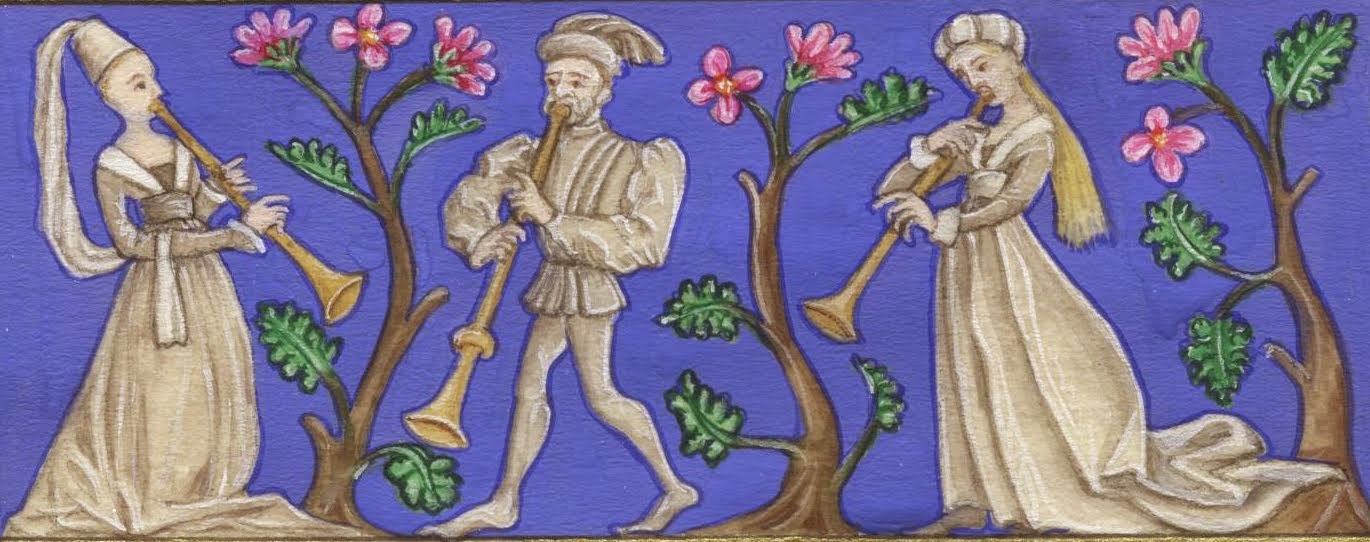A dance from the Brussels manuscript that is widely known in current historic dance circles is Danse de Cleves (here's the second and third pages). Many different reconstructions of this dance exist, because it seems that not all the intended steps were recorded in the manuscript. In his new book Mullally (see my previous post) comes up with a rather unique solution - without interpolating additional steps - but is it plausible?
Danse de Cleves is one of the handful of dances in the Brussels manuscript to have more elaborate mensural music, which might seem like a good place to start in deciding how the simplified breve notation of the other dances should be interpreted. Note in the following that I do not think there is any dispute that, in general, 'breve' = 'step', i.e., a double (d), two singles (ss), desmarche (r), or branle (b), as these numbers match up for nearly all the dances.
It is fairly apparent that there is a pulse of 3 in the music of Danse de Cleves. I'll call a set of 3 minims (the unstemmed open notes in the manuscript notation, resembling a modern semibreve) a 'bar' for the current discussion. The first repeated phrase in the music is then 8 bars long, then there is a 4 bar repeated phrase, and so on; the whole is 8+8+4+4+8+4+4+8+8=56. So this does not itself clarify if 2 or 4 bars should be taken to correspond to a breve or double step.
It is musically clear that if this tune is an example of diminuation of a sequence of breves (as suggested by Mullally p.23-24), that sequence must be moving every 2 bars. It is not possible to recover a plausible breve sequence from a 4-bar grouping of this tune. But conversely, if one did recover a sequence, it would be very atypical (rather more like a 'ground' than the sequences of breves found in the rest of the manuscript, perhaps one reason why modern audiences find the tune so accessible). So maybe this is not the best criteria.
Mullally says (p74) that "the vertical lines on the stave in the manuscript are an indication that, in transcription, there are four bars to each step". However, he does not comment here on the very striking arrangement of the text under the stave, in which the initial sequence of the dance (Rb ss ddd ss d^r, i.e., 8 steps) is carefully spread over the first 8+8 bars, and then at the strong musical change, the differing instructions for the man and woman (ssd + ssd) are squashed under the 4+4 bar phrases. There's even a little kink in the outline drawn from the stave around the text, to make the relation of text and music clear. It is hard to imagine stronger evidence that each 'ssd' takes 4 bars and not 8 bars, meaning each step (or breve) corresponds to 2x3 beats, not 4x3.
In fact this alignment has already been dismissed by Mullally, first on p15 "in the case of ... Danse de Cleves, the choreographical directions have sometimes been squeezed in wherever the scribe can find space" and then on p26 as "the steps are placed arbitrarily under the music".
So how does he (re-)arrange it (p52-53)? By taking each step to equal 4 bars, he stretches the initial 8 step sequence out to last 32 bars. The ssd+ssd he fits to bars 33-48, and then the final instructions, another ssd (perhaps ambiguous in the instructions if this should repeat, but which in any case appear in the manuscript to again be carefully aligned to the 4+4 musical theme, bars 33-40), he fits to bars 49-56.
Admittedly this has the advantage of not just making up something to fill in what appear to be missing steps under bars 25-32 and 42-56, which is the solution I have seen in all previous reconstructions (including my own). But it does seem the result would be either a very slow and boring dance, or a very frantic pace required by the musicians, or both.

Speaking as one of the dancers in this trial, I can attest that it was more pleasant to dance the '2 bars to a double' version. The 4-square version felt lumpen in comparison.
ReplyDelete